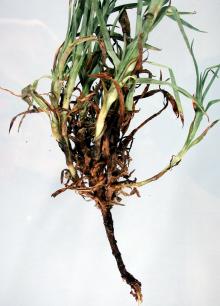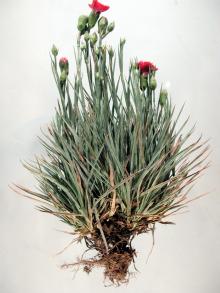See:
Carnation (Dianthus caryophyllus) - Stem Rots
Cause Fusarium oxysporum f. sp. dianthi, a soilborne fungus that infects plant roots or wounded cuttings. It survives in the soil as thick-walled, dormant chlamydospores, and on wooden benches used for plant production in the greenhouse. Chlamydospores germinate in response to exudates from nearby plant roots. Hyphae then penetrate the roots (wounded or not), colonize the cortex, and move into the xylem tissue which becomes brown. Small spores (microconidia) are produced and carried up into the plant. Infection of the vascular system interferes with water and nutrient absorption. As the plant dies, the fungus erupts through the epidermis and forms tuft-like structures called sporodochia. Spores formed on these tufts can become airborne and infect nearby soils and plants. These macrospores and mycelium in the host tissue convert to chlamydospores and are released into the environment as the tissue decomposes.
The fungus can be spread by soil, wind, water, infected cuttings, and contaminated tools, equipment and clothing. Suppression of fungus gnats has been report to prevent spread. Warm temperatures and conditions favor the disease. Potting media with peat or coir fiber are conducive to disease development. Amendment of soil with compost or manure with high levels of organic nitrogen has reduces incidence of the disease.
This fungus has been reported from Washington and found by the OSU Plant Clinic. Eleven races of the fungus are known, falling into six vegetative compatibility groups, but it is likely more complex than that. Race 2 is reported as prevalent worldwide. The cultivars Arbel and Scarlette seem to have a stable resistance to race 2.
Symptoms Lower leaves yellow, wilt, and dry up one side of the plant. Symptoms progress up the plant. The stem often shrivels and turns grayish and the xylem tissues turn brown. Shoots may be stunted and grow abnormally. The top of the main shoot grows at a right angle to the main stem. Plants may curl when symptoms develop on one side of the plant. Late in the disease, roots, and stems rot and the plant dies.
Cultural control Clean growing surfaces, clean water and handling practices along with soilless media are all helpful. Integration of several tactics is needed to manage this disease.
- Use culture-indexed plants free of the pathogen.
- Use sterilized soil or use a soilless potting mix. Well drained media is also needed.
- Avoid saturated media allowing it to dry down for a couple of days before watering again.
- Remove diseased plants from production areas as soon as possible.
- Thoroughly clean and sterilize the greenhouse between production cycles.
- Do not over-fertilize and keep media pH from 6.0 to 6.5.
- Preplant soil solarization has been helpful in reducing populations of certain soilborne pathogens and weeds in western Oregon. Place clear plastic (preferably anti-condensation film) directly on smooth, rototilled ground, which has been irrigated to field capacity and then allowed to drain for 1 to 2 days. Bury the edges of the plastic to trap the heat. Solarize for 4-6 weeks (or longer) during the hottest part of the summer, beginning in early- to mid-July. A similar practice can be done in the greenhouse.
Chemical control Not effective as a sole treatment but must be integrated with cultural controls. Use these materials preventively only at seeding or transplanting. Do not use to salvage the crop, as treatments are generally ineffective and only help increase the risk of developing resistant fungi.
- Heritage at 1 to 8 oz/100 gal water plus a non-silicone-based wetter sticker. Group 11 fungicide. 4-hr reentry.
- Medallion WDG at 1 to 2 oz/100 gal water. Use with oils or adjuvants may damage plant. Group 12 fungicide. 12-hr reentry.
- Terraguard SC at 4 to 8 fl oz/100 gal water. Group 3 fungicide. 12-hr reentry.
Biological control Use in conjunction with other control tactics such as thorough sanitation.
- Asperello T34 (Trichoderma asperellum strain T34) at 0.35 oz/35 sq ft of substrate before potting. See label for details. 12-hr reentry. O
- RootShield Plus Granules (Trichoderma harzianum Rifai strain T-22 and T. virens strain G-41) at 1 to 3 lb/cubic yard soil mix. Some California nurseries report it helps, but efficacy in the Pacific Northwest is unknown. No restrictions on reentry required when soil incorporated. O
- Bio-Tam 2.0, Tenet WP, or Obtego (Trichoderma asperellum and T. gamsii) at 0.5 to 1.5 lb/cubic yard of substrate. See label for details. No restrictions on reentry when soil incorporated. O
References Cañizares, M.C., Gómez-Lama, C., Garcia-Pedrajas, M.D., and Pérez-Artés, E. 2015. Study of phylogenetic relationships Among Fusarium oxysporum f. sp. dianthi isolates: Confirmation of intrarace diversity and development of a practical tool for simple population analyses. Plant Disease 99:780-787.
Borrero, C., Trillas, I., and Avilés, M. 2009. Carnation fusarium wilt suppression in four composts. European Journal of Plant Pathology 123:425-433.



